

How To Define Your Brand’s Tone of Voice: Infographics and Examples
source link: https://www.semrush.com/blog/how-to-define-your-tone-of-voice/
Go to the source link to view the article. You can view the picture content, updated content and better typesetting reading experience. If the link is broken, please click the button below to view the snapshot at that time.

In today’s era of content overproduction, the web offers a constant stream of content choices for your audience. In 2020, with the onset of COVID-19, that was especially true. Roughly 50% of Americans worked from home, generating tons of data.
In fact, every minute:
-
Twitter gained 319 new users
-
Netflix users streamed 404,444 hours of content
-
Consumers spent $1,000,000 online
-
Instagram Business profiles saw 138,889 clicks
-
Facebook users shared 150,000 messages. (Source: Domo, 2020)
And in this content chaos, it only takes users approximately 50 milliseconds (that’s .05 seconds) to form their opinion of your website.
This data shows how crucial that initial first impression is and how little time you have to make it count. And once you’ve got their attention, how do you make sure they stick around?
The answer is making your brand’s tone of voice distinctive and memorable. Tone of voice applies to creating any piece of content and communicating with your audience online.
Tone of voice reflects your brand personality, helps you connect with your audience, and makes you different from the rest.
Contents:
Let’s start with a tone of voice definition.
What Is a Tone of Voice?
When most people think about “tone of voice,” they imagine a spoken conversation: Do you sound angry? Happy? Cautious? Hostile? Often, when speaking out loud, people can communicate these feelings with listeners, regardless of their word choice. So what does “tone of voice” mean?
Written tone is created by the words and phrases you use when communicating, and how you structure your sentences. For example, using direct, second-person pronouns (such as “you”) and simple, casual phrases can create a friendly and inviting tone. Similarly, using only third-person pronouns (“he,” “she” or “they”), complex phrasing, and more technical terms and industry jargon can, by comparison, create a more formal, distant tone.
The tone of voice describes how your brand communicates with the audience and thus influences how people perceive your messaging. In other words, it describes how we want to communicate to our audience, rather than what.
Your company’s tone of voice represents your brand personality and values. This includes the words you choose and the order in which you put them and applies to all the content you deliver — website content, social media posts, emails, and any other formats.
As different purposes require different measures, your tone of voice may vary from time to time, depending on:
-
The audience you communicate with if you target more than one persona;
-
The media you use, as content formats and lengths vary;
-
The goal you are pursuing, e.g., the goal of a news piece is different from that of a how-to article.
But even if some situational changes are necessary, your overall tone of voice should be consistent throughout every piece of content you deliver.
Successfully defined and implemented, tone of voice allows your audience to recognize your brand by content alone, even if they don’t see your logo or company’s name attached to the content you produce.
Brand Voice vs. Tone of Voice: What’s The Difference?
While the two are related (and have similar names), brand voice and tone serve two distinct purposes:
- Brand Voice represents your brand’s unique perspective, and the values you stand for. In other words, this is your brand’s overall personality.
- Brand Tone of Voice is how your brand chooses to communicate. This can change somewhat based on what is most appropriate for the situation at hand.
In other words, to use yourself as an example: as an individual, you have a distinct perspective and personality, which remains essentially the same throughout all of your day-to-day interactions. However, the way you talk to people in each of those interactions may be different.
You probably use a different tone and phrasing when speaking to your boss, compared to writing a research paper, or when chatting with close friends in a casual setting. In the same way, your brand voice should remain consistent, even though you might need to adjust your tone of voice to suit a specific piece of content.
Why Does Your Company Need a Tone of Voice?
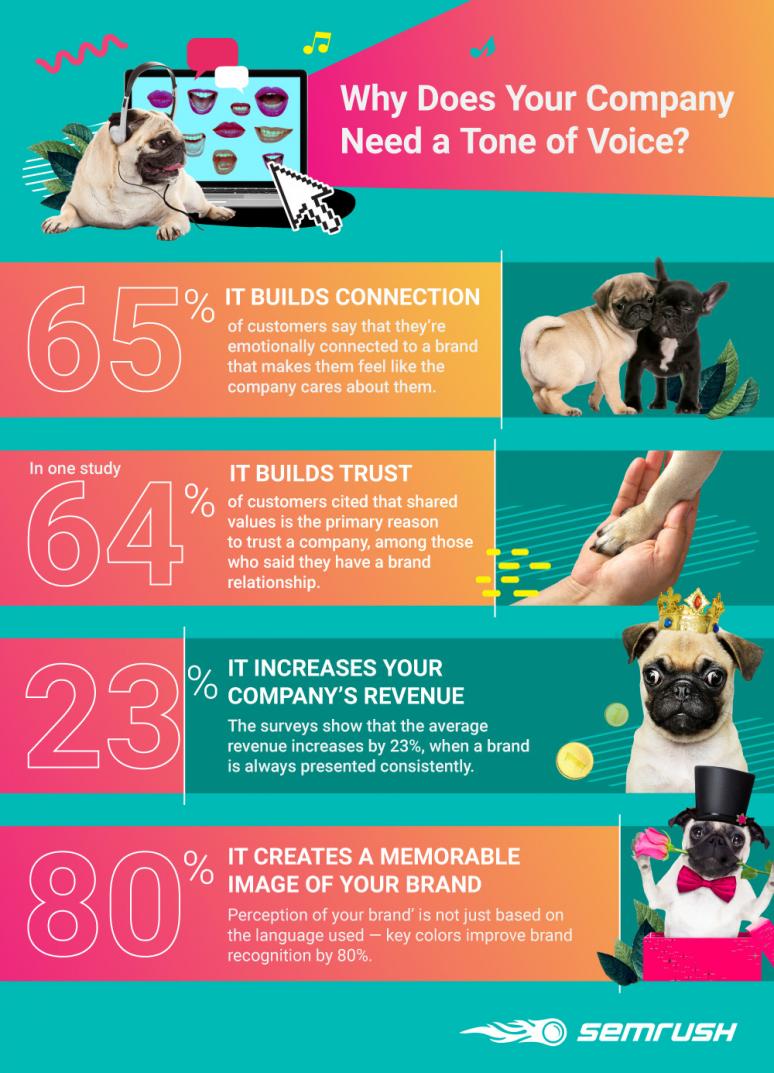
Tone of voice can have a major impact on your relationship with your audience, your brand identity, and even your overall performance:
-
It builds a connection with your audience that encourages a dialogue. 65% of customers say that they are emotionally connected to a brand in a way that makes them feel like the company cares about them. A caring or friendly attitude towards your audience can prompt them to interact with you more, giving you a chance to offer them a solution to their problems.
-
It builds trust with your audience. Trust can be built using different measures — in one survey, 81% of respondents said that it was important to them purchase from brands that reflect their values. To work towards this goal, highlight your charitable work, donations, and important events happening in the workplace.
-
It may increase your company’s revenue. A survey shows the average increase attributed to presenting the brand consistently, estimated by those organizations with brand consistency issues, is 23%. You have to make sure that your tone of voice is consistent across all the channels you are in.
-
It creates a memorable image of your brand and the people behind it. However, the perception of your brand is not just based on the language used — key colors improve brand recognition by 80%. This is extremely important to keep in mind for small or start-up companies where content is created without a designer’s assistance.
If this data has convinced you that your company needs a tone of voice and you are eager to define how to express your brand personality, discover next who is capable of defining a tone of voice and how to do it step by step.
Is your tone of voice consistent and relevant?
Check your tone of voice with Semrush SEO Writing Assistant

Who Has the Expertise to Define Your Tone of Voice?
Generally speaking, there is no single position that specializes in the tone of voice in every organization, so who is responsible for it depends largely on your team’s expertise and areas of need.
Tone of voice could be defined by an in-house specialist — a brand strategist, a content marketing strategist, a creative director, a writer, an editor, etc. — or an external party such as a brand consultant, a branding agency, or a freelance writer.
Every brand has its own organizational structure and unique branding story. No matter what position they occupy, the individual or team responsible for defining your brand tone of voice should have:
-
Analytical skills to conduct audience research,
-
In-depth knowledge of your brand culture to define your values,
-
Writing skills to determine how to express your brand personality, and
-
A will to change and unify the way your company uses language.
Let’s now see how a tone of voice is defined and implemented, with examples.
How to Find Your Brand’s Tone of Voice
Finding your tone of voice starts with understanding who your audience is and choosing the right language to reach them. The next step is to identify your brand’s values, which you should keep in mind when creating content and communicating with your readers.
Defining these elements can help you establish clear tone of voice guidelines, which your team can rely on as they create the communication your brand sends out. As team members become more familiar with the guidelines and how to use the brand’s preferred tone, it becomes easier to create new content that falls in line with this vision.
Let’s now start with your brand’s audience research.
Step 1: Get to Know Your Audience
According to a report by Salesforce, 66% of customers expect brands to understand them and their needs and expectations — but 66% also said they usually felt that they were treated like a number. In other words, many customers feel like brands don’t see or treat them as an individual person with unique needs, but rather as an anonymous figure in a crowd. To understand how to approach your audience and deliver relevant messages, you have to research properly and adapt your content to their personas.
Research Who They Are
Discover their gender, age, interests, education, job title — all the info you have access to. Examine their demographic information by delving into Google Analytics and social networks analytics.
Then use this data to craft a portrait of your persona. Remember that your audience isn’t made up solely of buyers — your audience may include everyone from loyal customers to potential future customers finding you for the first time.
Building out an effective persona can help you figure out how best to communicate with and relate to your audience — as a friend, as a teacher, as a caring grandma?
Source: Skype’s Brand Guidelines
Tip: A great way to relate more effectively to your audience is to think about which generations you’re speaking to. While each generation has a lot in common, their unique experiences do still have a big impact on the way they communicate.
For example, many Baby Boomers are now retired — or will soon be — and have embraced digital technology as a major part of their lives. Now that they’re home, they’re into everything from smartphones to health and wellness wearables and even gaming and esports. They’re also on Facebook a lot, and are 19% more likely to be influenced by online advertising than other generations.
Millennials are also very active social media users, where they engage with interests like home, wellness, and of course, their beloved pets to escape the stress they face in daily life. As a generation, they tend to value equality, particularly regarding family and household concerns, which also has a big impact on their engagement and purchase decisions.
Like millennials, Gen Z is also driven by shared values. Possibly impacted by the uncertainty their young adult years have been colored by, they are concerned about issues like climate change. They want not only the government but also organizations they engage with to demonstrate a commitment to resolving those issues. Also like millennials, they also have a preferred form of escapism-nostalgia, embracing things like vinyl records, 90’s fashion, cassette tapes and more.
One thing to keep in mind is that, in general, each generation tends to react to the one who came before it. For example, for many Millenials, the internet was still relatively new, and so they embraced it wholeheartedly — hence their continuing enthusiasm for email and social media. On the other hand, Gen Z grew up with the internet being a fact of life. That means that to a degree, they assert themselves by “disconnecting” and by pursuing unique in-person experiences. They use social media largely to express their individual identities by sharing those experiences.
Discover What They Are Reading
When your persona is created, figure out what channels they prefer to use for communication with brands to better adapt your tone of voice — delve into reliable online research.
Continuing the generations topic, according to a Data Axle white paper on marketing to each consumer generation,
- Millennials value both email and Social Media, particularly networks like Facebook, Twitter, and Instagram. They tend to be brand-loyal, driven by personalized, cross-channel brand experiences, brand philosophy, and loyalty rewards.
- Gen Z crave authentic, personalized brand experiences and quality products and services, and tend to value mobile apps over email and social media. While they prefer in-store experiences, it’s also important to reach them on their preferred social media channels: Facebook, Instagram, Snapchat, and increasingly TikTok (according to Forbes). You can also check the social profiles of your real customers and find out what resources and brands they follow.
You can also check the social profiles of your real customers and find out what resources and brands they follow.
Your goal is to identify the most authoritative resources and top social media pages where your audience discusses topics related to your industry. Use an automated tool like Brand Monitoring to find top forums talking about your industry terms and your own brand.
Tip: Remember that social content isn’t one-size-fits-all. Each piece you share should be tailored for the needs of that platform and the interests of the audience you’re targeting in order to be successful.
For example, the beauty brand Glossier focuses on building a community of young, like-minded beauty enthusiasts — and this has influenced not just their content strategy, but also their Instagram-friendly packaging and overall aesthetic. Here’s one example of how they approach this.
This Instagram post brings together the Millennial interest in wellness and self-care, with the aspirational, experiential perspective of Gen Z, while also appealing to the visual nature of the Instagram platform:
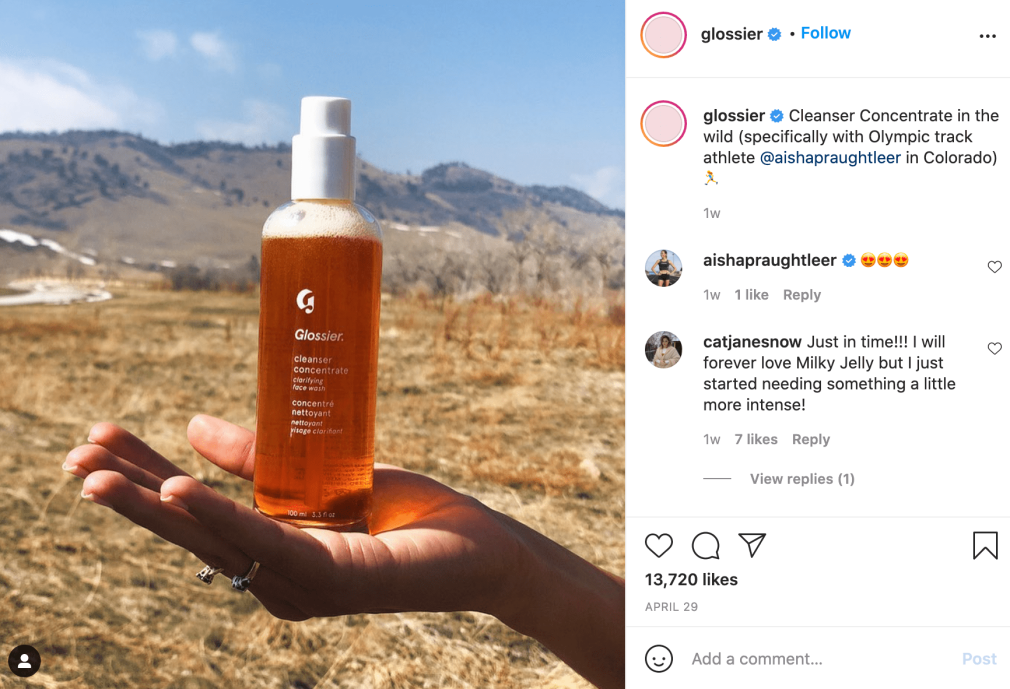
Watch How They Talk to One Another
Next, dig into these resources — and take your time to research. Pay attention to how your audience communicates with peers, what they like and dislike in discussion threads, the overall tone of discussions, and the language people use to create the most popular content.
Experts say that mirroring the communication patterns, tone and body language of a particular group allows members to feel a sense of belonging. Mirroring how your audience communicates can make your content pieces more relatable. If done right, this can even lead to an increase in sales.
Empathy is also increasingly important. Especially during times of crisis, people want not only to understand your tone and motive, but also to know that you understand them.
Tip: Don’t be afraid to speak to your audience on their level. Engaging with your audience’s interests, even if those interests don’t immediately align with your product or brand, can be a great way to show the fun side of your brand’s personality, and foster a connection.
Take, for example, this creative Star Wars Day post from Arby’s:
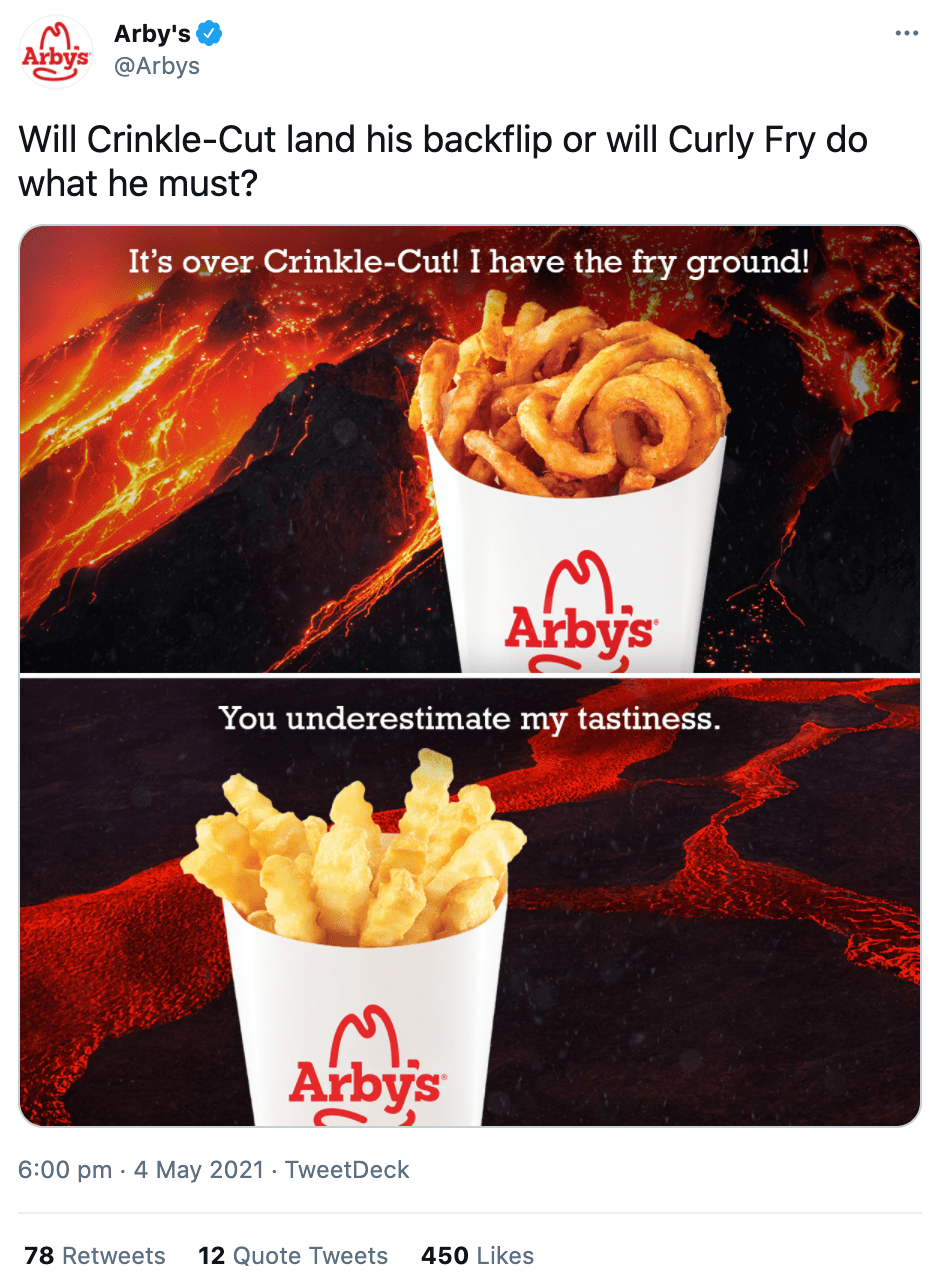
Not only does it appeal to a popular cultural touchstone, but it puts a creative spin on an annual meme (“May the 4th be With You”) popular with the millennials they’re targeting.
Some brands choose to engage with their audience more directly, encouraging them to share their own unique work and using their platform to celebrate their achievements.
For example, take a look at this Twitter post from Newegg celebrating a user’s custom PC build:
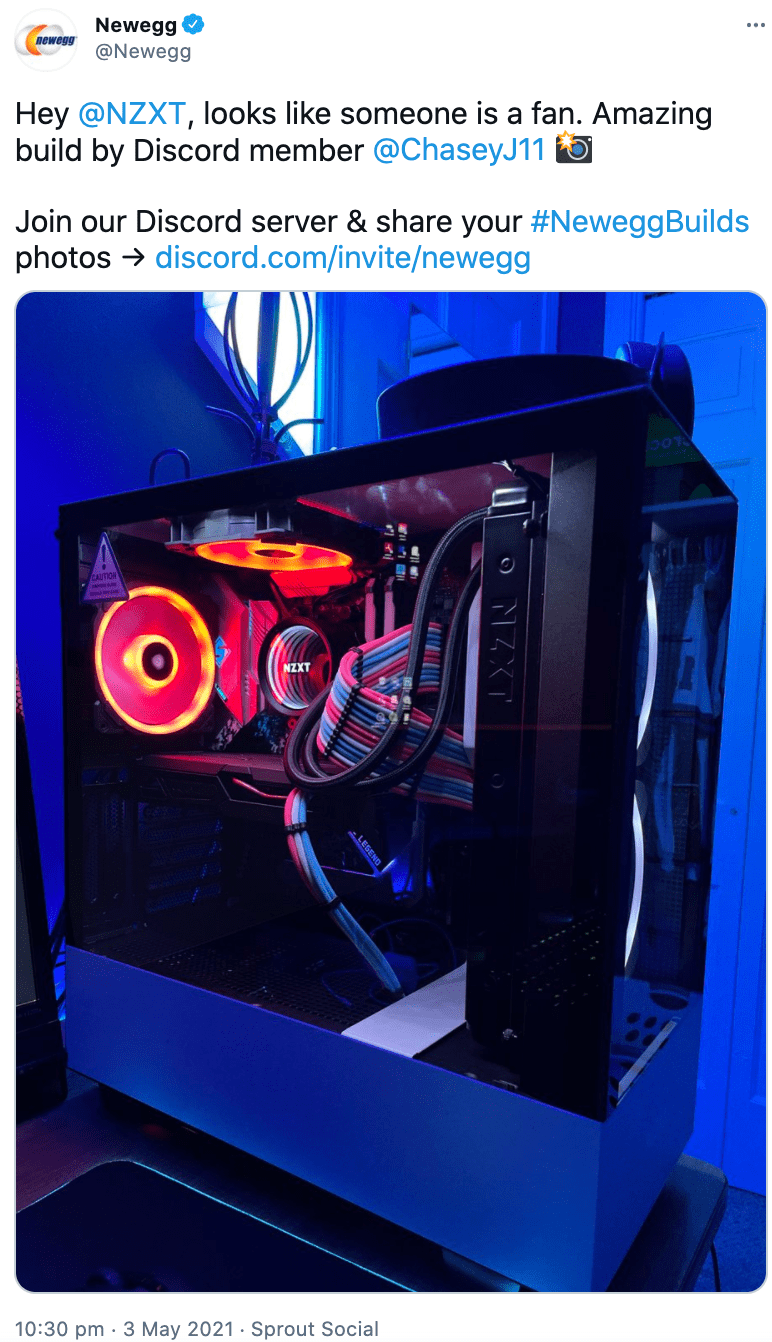
Ask Them to Describe Your Brand
Traditional market research techniques, like customer surveys or interviews, are a great way to hear directly from people who are already familiar with your brand. If you haven’t outlined your tone of voice guide yet, this doesn’t mean that your brand doesn’t have an evident personality.
Ask your clients what their perception of your brand is and what events or content pieces have influenced this view. Here are some questions that you can send to them:
-
How would you describe our brand in three words?
-
If our brand were a human, what type of person would it be?
-
What content piece/email/tweet of our brand best represents us?
Keep the descriptions you get, for now; we will get to them in the third step.
Tip: Head to our Ultimate Guide to Content Marketing Strategy in 2021 to find more advanced audience research techniques, like:
-
The Empathy Map to improve user experience based on what your audience think, feel, see or hear, and
-
The “Jobs to Be Done” Framework to better understand your customers’ needs and to find the reason why they are buying your product.
Step 2: Identify Your Brand’s Values to Communicate
Before you decide on what you should write, define the core purpose of your communication. This should be informed by your company’s core values.
Identifying your core values will help you not only to find the language needed to communicate your message effectively, but also shape the community surrounding your brand, and ensure that you connect with your customers.
Define Your Core Values
Transparency is crucial when it comes to building trust with your customers. In fact, 95% of consumers surveyed said that they were more likely to be loyal to a company they trust, and 92% said they were more likely to buy additional products or services.
To define your core values, start by answering these questions:
-
Why was the company set up?
-
What makes your brand unique?
-
What do you stand for as a brand?
-
What values do you want to share with your audience?
There are no perfect templates for outlining them, but you can learn from others — here is an excellent example of a core values statement by Zappos; this makes it easy for both employees and customers to know what to expect when interacting with Zappos.
While many companies do publish their core values on their websites, you’re not required to do so. If you choose, you may instead keep this for internal reference only.
Create a Mission Statement
After you have defined your brand values, the next step is to compose a concise brand mission statement for your audience. Show your readers who you are, what and who you care about, and how your brand can help. You can also specify what your company does to uplift its team.
Here is an example of an editorial mission statement by Stephanie Stahl, CMI's tone of voice and brand messaging manager. (Source: Foleon)
Content Marketing Institute is the leading global content marketing education and training organization (that’s who we are), teaching enterprise brands (that’s the audience we are creating content for) how to attract and retain customers through compelling, multi-channel storytelling (that’s how we are going to help them).
— Stephanie Stahl
Remember that your entire team must operate in alignment with these values.
A well-defined mission statement shapes your brand’s culture and allows your audience to relate to your company, especially if those values are shared.
Establish a Message Architecture
To keep your communication aligned, a message architecture guides precisely what we say.
A message architecture summarizes a brand’s prioritized communication goals in a shortlist of terms, phrases, or statements. Its primary goal is to allow all content creators in a company to deliver consistent messages across all types of content.
A message architecture is an outline or hierarchy of communication goals that reflects a common vocabulary.
— Margot Bloomstein
Margot Bloomstein, Brand & Strategy Consultant and an early proponent of the term, shares her advice for building a message architecture.
Compile a list of up to 50-100 adjectives most applicable in your industry (or take a list from her book), invite your stakeholders and sort them together into three groups:
-
Who we are.
-
Who we would like to be.
-
Who we are not.
Focus on the “Who we’d like to be” column, group your adjectives into affinities and organize them in order of priority. You can then flesh these out with sub-bullets and color-coding as needed, to help clarify their meanings. Finally, update your content strategy with your completed message architecture.
A message architecture can take various forms. Margot’s interpretation for a “stately financial institution” looks something like this:
Source: CMI, 2016
This type of message architecture describes not just what this institution is like, but also what it does.
A message architecture is not a brand voice chart but should complement it. It describes what we want to communicate to our audience, rather than how.
Also, keep in mind that a message architecture is not a glossary of words to use in your content, but prioritized reference points for your team to decide what to communicate in order to convey your organization’s messaging priorities.
Make sure you distribute your message architecture to all content producers in your company and all people involved in content creation.
Step 3: Audit Your Content and Communication
Before creating a tone of voice that fits your company, audit your existent content pieces and communication to see what your brand sounds like right now.
To do so, make a list of your top-performing (according to your content metrics) and best (in your opinion) content assets, and ask yourself if your current tone of voice:
-
Fits the brand values you want to communicate?
-
Reflects your values described in your mission statement for your audience?
-
Corresponds to your message architecture?
Go through each content piece and register (e.g., in a spreadsheet) what your brand sounds like. To help content strategists and other specialists to analyze a website’s tone of voice, Nielsen Norman Group identified four dimensions of tone of voice:
-
Funny vs. serious
-
Formal vs. casual
-
Respectful vs. irreverent
-
Enthusiastic vs. matter-of-fact
Spoiler: We will analyze each of these in the next chapter.
Use the SEO Writing Assistant to make sure each of your content assets aligns with the formal or casual tone of voice. The tone of voice feature is powered by a machine-learning algorithm and thousands of human-rated pieces of text.
See where your brand’s tone of voice falls the most among each of the four dimensions. Then express your tone as a point in the 4-dimensional space like this:
Source: Nielsen Norman Group, 2016
Tip: Don’t forget to go back to how your customers described your brand in the interview/surveys and check how their description aligns with yours. If it doesn’t, include their characteristics in your findings.
This visualization will tell you what your brand sounds like right now and help you get closer to the way you want to sound, in compliance with your brand values.
Step 4: Define Your Brand’s Tone of Voice
We have finally gotten to the step where you combine all the information you’ve collected through research — your audience portrait and brand values — and use it to define your brand’s tone of voice.
A tone of voice should address two elements:
-
What you sound like.
-
What you want to sound like.
Using the Nielsen Norman Group’s dimensions, you can then identify not only what you want your brand to sound like, but also what you don’t want. Then, you can use that information to refine your new tone and create a brand voice chart.
Keep reading to learn about each tone of voice dimension and see different companies’ tones of voice exemplified by their customized 404 pages.
Choose the Dimension of Tone of Voice You are Aiming at
Spoiler: casual, conversational, and moderately enthusiastic tones perform best.
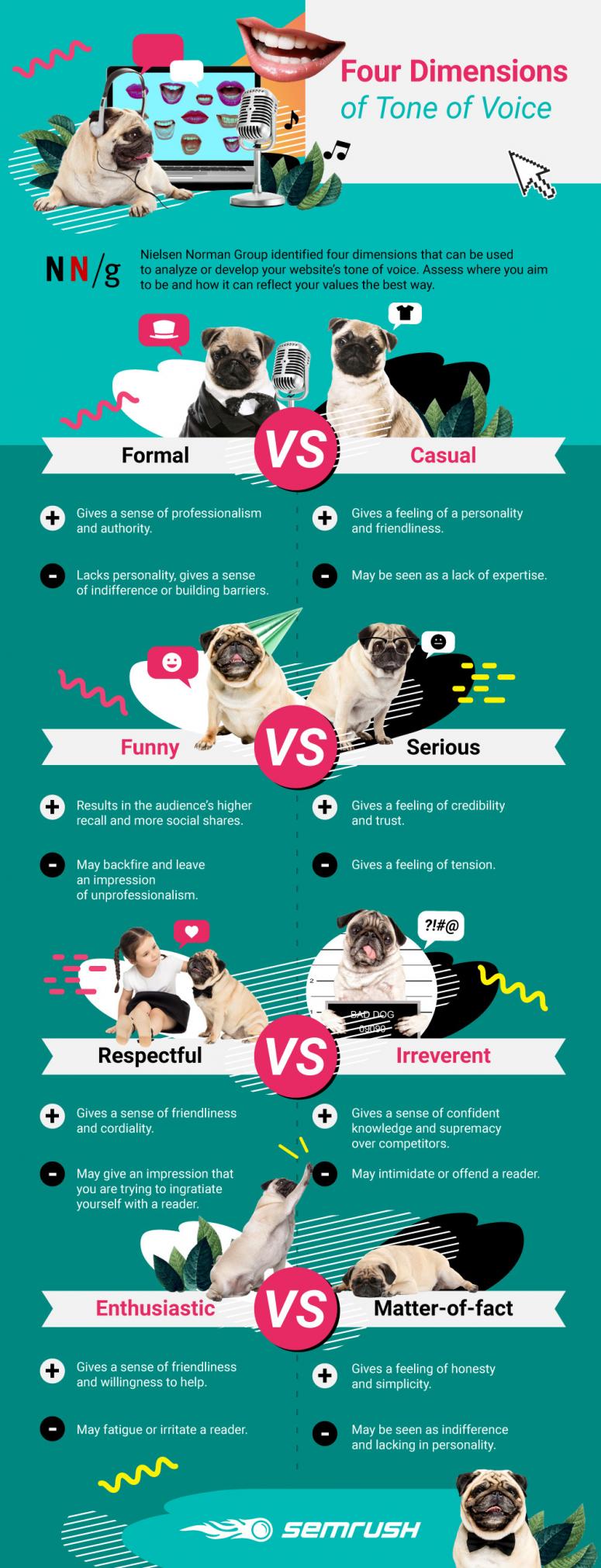
Formal vs. Casual
Choosing your preferred level of formality is crucial because it has such a big impact on how customers perceive your brand. For example, using very formal language can help you appear more authoritative, but may also feel more impersonal.
In contrast, casual language can help create a sense of personality and friendliness, but being too casual in the wrong context could make you seem inexperienced or unprofessional.
Surveys show that 65% of customers preferred their support staff to have a casual tone during their interactions. However, that also depends on the context, according to Jay Ivey, an analyst at Software Advice — 78% of customers would be dissatisfied if their request was denied using a casual tone. By contrast, if a request was approved in a formal tone, only 35% said it affected their satisfaction. Researchers attributed this to a casual attitude being perceived as condescending or insensitive in specific contexts.
The Alfa Romeo brand is a union of both rational and emotional. However, their brand voice tends to be more formal than casual. Here is an example of their 404 page, explaining in detail why an error appeared in a formal passive voice.
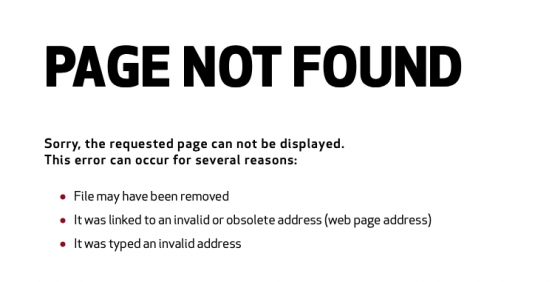 Source: Alfa Romeo
Source: Alfa Romeo
Mini is straightforward, sincere, and engaging. Their 404 page reflects their personality in a casual way — in contrast with Aston Martin, they use an active voice and add a romantic touch.
 Source: Mini
Source: Mini
Funny vs. Serious
Humor can increase the power of memory recall and get more shares, which allows you to stand out from competitors — as long as your audience finds you funny. However, humor is always a risk in brand communication that can backfire. Used unwisely, it could alienate your users, leave the impression of a lack of seriousness, and as a consequence, unprofessionalism.
Introducing a more serious tone will help to build credibility and foster trust. But it may seem that serious language lacks in personality and emotions, and even gives a sense of tension.
When making a choice between a funny and serious tone, remember that a funny tone won’t fit all companies, but most importantly, humor shouldn’t get in the way of actually communicating with your audience.
Mailchimp is an iconic brand that doesn’t take themselves too seriously. They use offbeat humor and a conversational voice in all brand communication, and their 404 page is no exception.
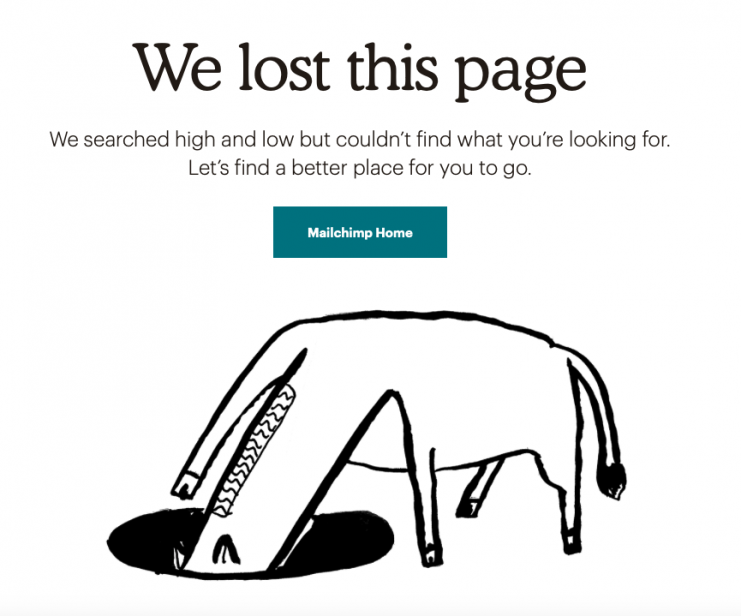 Source: Mailchimp
Source: Mailchimp
SendinBlue, in contrast, is positioned in a more serious way, in spite of the fact that they both offer very similar services. Their 404 page is completely different from Mailchimp and doesn’t include any humor.
 Source: SendinBlue
Source: SendinBlue
Respectful vs. Irreverent
Respectful language gives a feeling of friendliness and cordiality. But, an overly respectful tone, especially used at inappropriate times, may give the impression that you are trying to ingratiate yourself with a reader.
An irreverent tone helps your brand seem confident and authoritative, and even give a feeling of supremacy over competitors. However, irreverent language can intimidate or offend a reader.
Dollar Shave Club is an excellent example of a successfully implemented irreverent and disruptive brand voice. Here is their customized 404 page, which perfectly illustrates this — Dollar Shave Club offers a gif and an invite to buy some of their products.
 Source: Dollar Shave Club
Source: Dollar Shave Club
Gillette, in contrast, tends to communicate respectfully and use a caring voice when addressing their audience, which is reflected in their 404 page where they say that it is Gillette’s job to fix it.
 Source: Gillete
Source: Gillete
Enthusiastic vs. Matter-of-Fact
An enthusiastic tone gives a sense of friendliness and helpfulness, but used at inappropriate times it may fatigue or irritate a reader.
Matter-of-fact language gives a feeling of honesty and simplicity. But, executed poorly, it may be seen as indifferent or lacking in personality.
Taco Garage takes a matter-of-fact attitude, selling “real tacos for real people that taste real good.” Their tone of voice is uncomplicated and straightforward; their 404 page is as simple as they are.
 Source: Taco Garage
Source: Taco Garage
In contrast, Taco Bell’s brand voice is enthusiastic, adventurous, humorous, and extremely creative. Check out their 404 page to get a sense of their personality.
 Source: Taco Bell
Source: Taco Bell
Refine Your Tone of Voice with a List of Tone Characteristics
After you have identified where your brand falls within each dimension, refine it by choosing more specific tone characteristics, like “playful,” “quirky,” or “sarcastic.”
Norman Nielsen Group created a list of 37 tone-of-voice words that you can use for this. We broke down this list for you into four dimensions. However, you can attribute some of these words to another dimension or choose any other words to describe your brand.
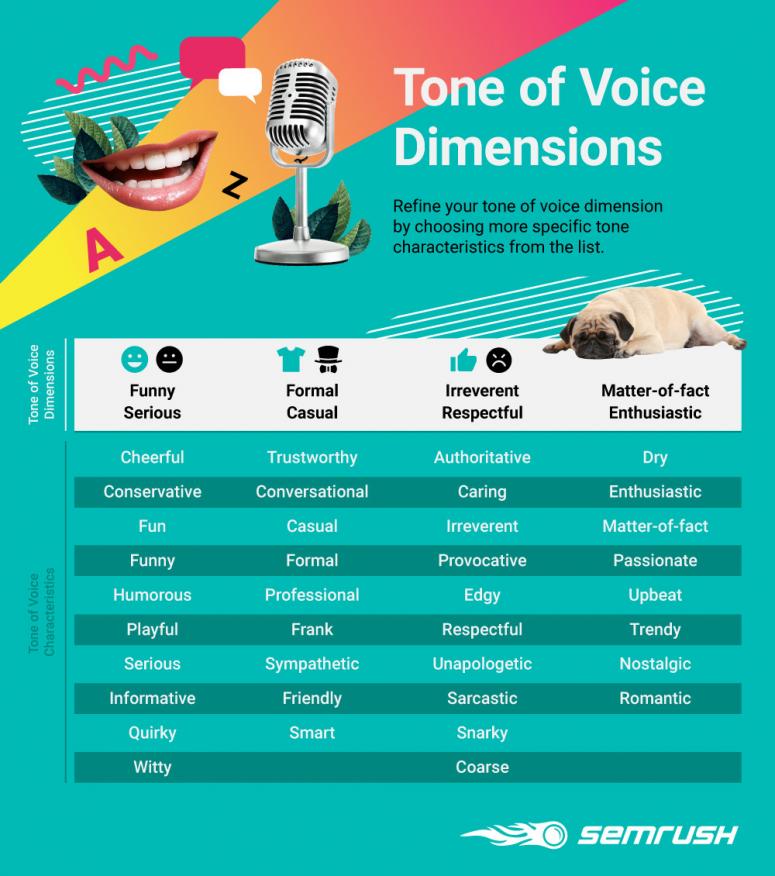
Once you have defined and refined your desired tone of voice, merge “What we sound like” and “What we want to sound like.” Check if you have conflicting ideas and unify them.
Create a Brand Tone of Voice Chart
Combine all voice characteristics into a single chart using the CMI template below, describe each of them in detail, and give examples of how you can achieve the specific voice. The critical part here is to illustrate what you should avoid.
Source: CMI, 2018
If you need help here, work with writers on how to express your voice characteristics linguistically.
The next step is to create a brand’s tone of voice guidelines, share it with your content team, and ensure it is followed in each communication type.
Step 5: Implement the Tone of Voice Into Your Brand Communication
To successfully implement your tone of voice, start by setting clear brand guidelines, and make sure they are reviewed every once in a while, especially when there are changes in your positioning and target audience.
Create Your Brand’s Tone of Voice Guidelines
Clear guidelines, rules, and positive examples give people the confidence to write in this new way. Many brands have them, but only one-fourth have formal guidelines that are consistently enforced.
Start with writing your guidelines in the brand’s tone of voice you have defined — this will be a perfect example of correctly using it when writing.
To ensure the guidelines are easy for team members to follow, include some examples of the tone of voice to strive for in each piece. In addition, examples of the incorrect tone of voice will assist writers on what not to do.
Your internal guidelines should include:
-
A portrait of your target audience and their voice,
-
Your brand’s attitude to your audience (a best friend, an aunt, a teacher, etc.),
-
Your brand’s core values,
-
Your mission statement,
-
Your message architecture,
-
Your brand voice chart,
-
Specific vocabulary, and grammar rules,
-
Clear examples in different contexts.
Establishing specific vocabulary and grammar rules, along with examples of what you mean, can go a long way to clarify your brand and tone of voice for content creators, and even help the editorial process go more smoothly.
Here are some examples of the kinds of vocabulary and grammar rules you might consider:
- Grammar and punctuation: How closely do you want to adhere to strict grammar rules? If you’re following a specific style guide (like AP Style or Chicago Style), now is the time to say so. Or can your writers break the rules, for example by using sentence fragments, double negatives for emphasis or humor, the way casual speech often does? If you’re using writers from around the world (for example, speakers of US and UK English) it might also be helpful to specify which spelling and grammar rules you’re going to align with.
- Slang and swearing: If you do have a more casual voice, can your content use current slang, and can you swear? Slang and swearing may not be appropriate for every brand or audience and even if it is, it’s a good idea to establish guidelines for what, specifically, is and is not acceptable and why. (For example, your brand might decide it’s okay to use certain swear words, but that it’s absolutely not okay to use others, because they contradict your brand’s values.)
- Technical language: Sometimes, highly technical language is appropriate, particularly if your audience is made up of experienced professionals who also communicate that way. On the other hand, if you’re talking primarily to casual consumers who don’t have that level of related technical experience, keeping it simple is probably better.
- Pronouns: When you’re writing for a broad audience, this can be important to clarify. Is it okay to write in second person, directly to your audience (using words like “you”)? This can help to create a more personal, casual tone, if appropriate for your brand. By contrast, if you want to keep things more formal, you might want to limit writers to a third-person voice (using “he,” “she,” or “they” pronouns, but not “I” or “you”).
Get inspiration from other companies’ brand voice guidelines and style guides:
Introduce Rules for Your Brand’s Tone of Voice Usage
Over 60 percent of organizations in the study report that materials are always, often or sometimes created that don’t conform to brand guidelines. Remember that tone of voice should be consistent across all your communication.
Assign accountability for enforcing the guidelines to one team member, such as an editor or content manager. This will help to ensure that all of your brand’s communications use the right words to distribute the right tone in all of its deliverables.
In Conclusion
Defining your brand’s tone of voice and establishing clear guidelines will help that tone move to the forefront in every content piece. This is a key part of developing a content strategy that is true to your vision and appears authentic to customers.
With a clear idea of where your audience lives online and what topics they want to hear more about, you can develop a vision of what your brand wants to say and determine how to use the right language to get this message across.
By keeping a uniform tone across all your communications, your audience will gain a better sense of what the brand stands for and what commonalities you share with your target audience.
Enhance Your Brand Content Strategy
Using Semrush Content Marketing Platform

Recommend
About Joyk
Aggregate valuable and interesting links.
Joyk means Joy of geeK